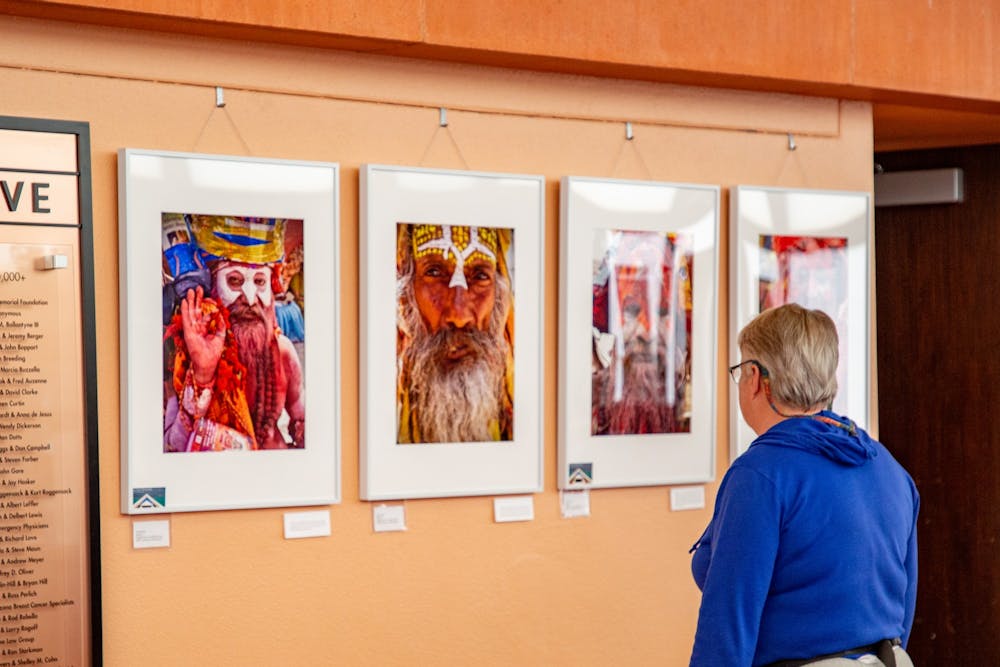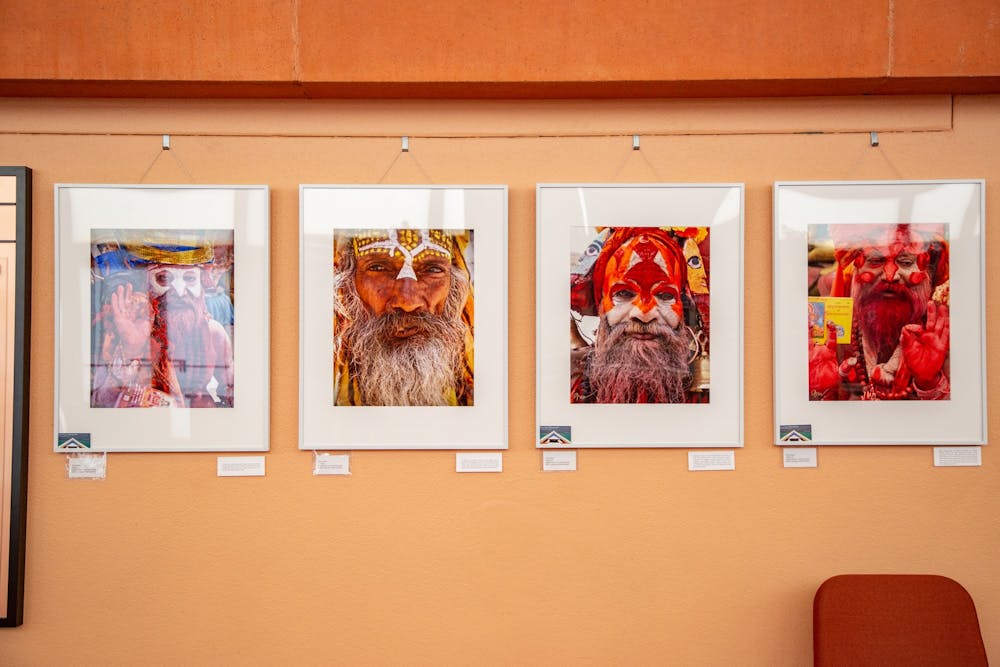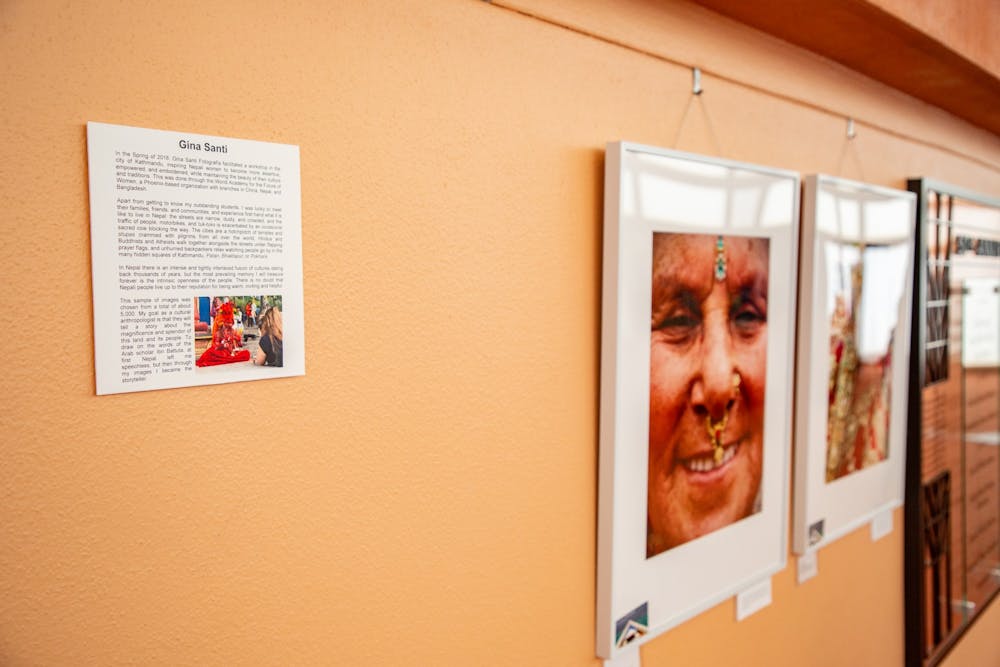Gina Santi's visual anthropology work depicts Nepali locals in bright hues of red, orange and blue and is currently featured on ASU Gammage's lobby walls.
On display since the beginning of February and until April 13, the 20 images act as symbols of the artist's vision to dismantle prejudices and harmful misconceptions of the Nepali people.
From 1-4 p.m. on Mondays by way of three consecutive hour-long viewing slots, the public can examine the images that showcase native life and the cultural heritage of Nepal. Visitors attending events at Gammage at other times can also view Santi's work while they're there.
Santi is a Venezuela-born freelance photographer, anthropologist and teacher who aims to capture global communities through her visual work. She began her illustrious and lengthy career by migrating to the United States to study business administration, explaining that she worked initially "in the corporate world for a multinational corporation."
"I was miserable," Santi explained. "But hey, you know, it was my career."
After establishing herself in her business career, she began to take a Spanish language course recreationally. As a native speaker, Santi flourished in her studies.
Santi's professors encouraged her to pursue teaching, and she began taking education classes to receive a degree in the field.
"Then we (my husband and I) moved from Maryland to Arizona, and I started teaching at NAU, and part of the perks of being a faculty member is you get free tuition," Santi said.
She then went on to receive a Master of Arts in Anthropology from the school, which she said changed the course of her life and career.
"We're in Arizona, we're in the perfect place to study anthropology," Santi said. "So I studied social anthropology, and it made me understand who we are as human beings. It made me a better human being.
"We have Native American groups right in our backyard," Santi added. "You can go and see petroglyphs, you can go to the Grand Canyon and you can see dwellings."
Santi explained that over the years, she has honed her skillset in anthropological study and photography by documenting the cultures that she visits, adding that "visual anthropology is a very popular field nowadays."
Hjorleifur Jonsson, a professor of anthropology at ASU, has extensively studied "highland or forest minorities ... in Thailand, Cambodia and a little bit in Vietnam." He is currently researching and teaching Southeast Asian sporting events, festivals, films and other cultural events.
Jonsson said utilizing a visual medium while conducting an anthropological study is unique in that researchers can record, analyze and display their work in an accessible way.
"I think visual photographs and video is the best way to reach people who are not interested in reading articles and obscure journals," Jonsson said. "It offers an immediate connection, and I think that's the aim of the photographs in Gammage — it's visually striking and colorful.
"You draw people into a complicated setting with a direct, one image ... and (that) makes them interested in stuff that otherwise they might never become familiar with," Jonsson added.
He explained that "cultures are always changing," and that tourism can act as a "stimulant for displays of tradition."
"There's also a very interesting contradiction here in that Western tourists view themselves as very modern, and (yet) they're very interested in traditional, non-modern things in other parts of the world," Jonsson said. "Our worldview leads us to expect that traditions are from the past, and in some ways, traditions are always being created and recreated."
The importance behind an open mind
Jonsson said in his work, it is crucial to keep an open mind to what is being culturally embraced in one society, as culture in the Eastern world is just as fluid and ever-changing as ours.
"Anthropologists have done documentaries about places and peoples and issues with the explicit purpose of educating people in the West about certain things," Jonsson said. "And in many ways, it has no impact — people don't want to learn."
In other words, Jonsson believes that people, including anthropologists, often want to hold onto existing ideas about what a society is like, instead of learning about how it has changed.
Rather than acting as an anthropologist in the ways Jonsson described, Santi focused on letting her Nepali subjects speak for themselves through her images.
Santi said she was initially chartered to do visual anthropology work in China for three months by the World Academy for the Future of Women who then asked her to continue with her work in Nepal.
"As an anthropologist, any opportunity that you get to be a participant observant … you grab it," Santi said.
Santi explained her Venezuelan identity and upbringing in Caracas have given her a unique approach to her work.
"I grew up in a culture that is very colorful, that is very loud, that is very open," Santi said. "That has allowed me to approach people in ways that not everybody can.
"In Hispanic cultures, the personal space is not as big as it is in other cultures," she said. "So you approach people, you talk to people, you start a conversation, and that makes my subjects more open to communicate. That has helped me a lot."
Tashi Gurung, a PhD student at ASU who focuses on sustainability and the impacts of tourism in Nepal, grew up in Nepal and migrated to the U.S. to pursue his education in sustainability, tourism, climate change and the relationship between the three.
Gurung has done extensive work in Nepal, most notably crafting a 2013 documentary detailing the lack of water access in local communities and how it has put strenuous pressure on Nepalis' culture and lifestyle.
Nepal, a country with an agriculturally based economy, is "very diverse" in multiple ways, including language and religion, Gurung said.
He said that the growth of tourism in Nepal has generated "economic inequality" and "social injustice," for "(in Nepal) you see a lot of business, but those businesses are not owned by the locals, they are owned by the funders.
"The local people don't get much benefit but they have to suffer," Gurung explained. "Whether it's pollution, whether it's over-tourism, if it's as simple as traffic jams, the locals have to suffer."
Gurung also said that climate change is another issue that Nepali people have to deal with in the modern world.
He said that many Nepali people view tourism as an "incentive to preserve, to maintain their cultural integrity."
Gurung said a main concern for Western tourists visiting Nepal should be to "be mindful" of the cultural differences and ask "what are the do's and don'ts."
"What you think is appropriate in one culture is not appropriate in other cultures," Gurung said.
Looking for 'the common humanity'
Taking into account these factors, Santi sought out to tell the story of the Nepali people in its most natural form through a medium that offers immediacy and intimacy.
Santi currently works solely in a photographic medium, but hopes to delve into anthropological filmmaking in the future. She believes the overarching objective of a body of work is an extremely important aspect of gathering photographs.
Julie Anand, an associate professor of photography in the School of Art and sustainability scholar in the Julie Ann Wrigley Global Institute of Sustainability at ASU, explained that "it's very difficult to photograph people who are different from you in an egalitarian way because photography is such a strong power tool."
Anand said in her fine art program she instructs students to "not exoticize people" and emphasized "the importance of the person's gaze who you're photographing because it is such a powerful tool."
She explained the ASU School of Art is "hyperaware" when taking photographs of contrasting subjects and actively works toward minimizing harm with the photographs it produces.
"Exoticism has to do with the consumption of the other, basically for pleasure," Anand said. "It's a really tricky thing, and we talk about it with our students."
Anand said photography is unique in that "even in the digital age, it's really tied to the real."
"We still have this sense that something real happened before the camera," Anand said. "And that makes it really palpable in a way that a painting ... doesn't. It doesn't have that same aura, it doesn't have that same power."
While viewing Santi's work, Gammage attendees should "think about the overlap between common ground and difference" and "look for the common humanity," Anand said.
"Be conscious of your own power and privilege as you look (at this work)," Anand said. "The people in the images don't have the ability to look back at you, and you're getting to study them."
Santi said she aims to challenge misconceptions of Nepal through capturing her subjects in their natural, vibrant environment.
Rather than portraying poverty, she opted to convey the "beauty and the color of Nepal" and hopes viewers can rid some of the prejudices and stigmas that they have against people from that part of the world.
"These people are human beings that laugh," Santi said. "They play. They cry. They have the same hopes. They just want to be happy. They want to have a life with dignity just like everybody."
Reach the reporter at stellefs@asu.edu and follow @samtellefson on Twitter.
Like The State Press on Facebook and follow @statepress on Twitter.






